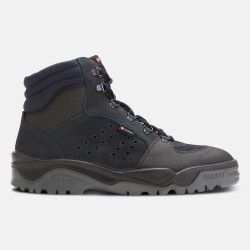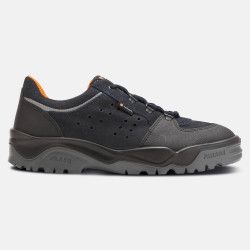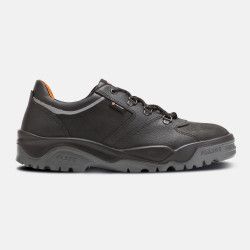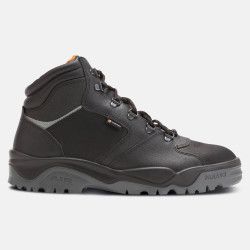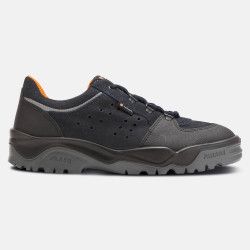Product presentation
MISCONCEPTIONS ABOUT THE COMFORT OF SAFETY SHOES
It's sometimes said that safety shoes aren’t comfortable, but that's a common misconception! Through innovation and the development of exclusive technologies, Parade Protection is constantly improving its products to perfect the combination of "safety" and "comfort" in its footwear.
Discover the possible causes of foot pain, the best practices to avoid it and, finally, some advice on how to choose the right safety shoes.

WHERE FOOT PAIN COMES FROM
In the workplace, foot injuries such as punctures, crushing, lacerations and sprains can occur as a result of poor footwear. Some injuries can also result from falls, missteps or slips. Workers' feet can also suffer from blisters, calluses, ingrown toenails, cracks or fungal infections. All these ailments cause discomfort and can have serious consequences on a worker's health and safety. General fatigue can also be a factor in addition to foot pain, which can cause other complications for the worker, such as joint pain (RSI) and possible clumsiness likely to cause incidents of all kinds.
Shoe discomfort can occur when one of the following factors is overlooked: the morphology of the foot, the weight of the wearer, the posture adopted at work, the nature of the environment, as well as poor user practices.
There are many main causes of discomfort:
- Safety shoes that do not fit the worker's feet properly. We know that a large proportion of professionals wear shoes that are too big.
- Lacing that is too tight or too loose can cause a host of problems: blood circulation problems due to foot compression, blisters, inflamed tendons, cramps, sprains, etc.
Advice: To tie your shoes properly, check that your heel is in contact with the back of the shoe, then tighten the laces starting from the toe, eyelet by eyelet, without compressing the foot. If you do a lot of moving around in your job, we advise you to relace your shoes every 2 or 3 hours, as the foot swells during the day. Do the same if there is a sudden change in temperature, as this will affect the volume of your foot.
- Too much perspiration from feet in shoes.
Advice: In the evening, take the protective insoles out of your shoes to dry, change your socks regularly and use products that reduce perspiration.
- Prolonged standing. The human foot is designed for mobility, so prolonged standing is tiring. Standing for hours on end strains the feet and can cause damage to the rest of the body, such as musculoskeletal disorders (MSDs).
Advice: Any working posture can be redesigned with the aim of improving comfort, safety and efficiency at work. To break up prolonged standing, you need to alternate between different working postures and walk as regularly as possible.
- The structure of the floor can also affect foot pain. Hard, rigid floors, such as concrete, are the least comfortable surfaces. By way of illustration, working on a hard floor produces the same effect as a hammer hitting your heel every time you take a step. As for slippery floors, these can cause falls and slips that lead to sprained ankles or fractured bones in the foot.
Advice: To avoid injuries and discomfort, you can:
-install wood, cork or rubber flooring on hard floors. Or use an anti-fatigue mat that provides cushioning to reduce foot fatigue.
-for slippery floors, use a non-slip coating. Caution: non-slip coatings of this type mean that the soles suddenly stick to it and the feet slip inside the safety shoes. The heat produced by rubbing can cause pain, leading to the formation of calluses. A soft, non-slip insole can reduce this discomfort.
BEST PRACTICES TO PREVENT FOOT PAIN
Daily care of your feet is essential to avoid any hygiene problems with the skin or nails:
- Wash your feet every day with soap, rinse well and dry thoroughly, especially between the toes.
- Trim toenails in a straight line but not too short; do not trim the corners.
- Wear clean socks and change them daily.
If you have problems with profuse perspiration, apply the above hygiene rules. In addition, you can use an antiperspirant, wear white wool or cotton socks and opt for leather or canvas shoes, which are breathable materials.
If you experience persistent foot pain, infections or other more serious conditions, you should consult a doctor, physiotherapist or chiropodist.
Finally, one of the most important steps in preventing foot pain is to choose safety footwear that is suitable for your feet.
HOW DO I CHOOSE MY SAFETY SHOES?
When foot pain occurs, you must identify the areas of pain. This identification will help you choose safety footwear that suits your feet. Follow the advice below to choose safety footwear that respects and matches the anatomy of your feet:
- Choose your shoe size carefully. There's a tendency to think that safety shoes need to be oversized to be comfortable. In a shoe that's too big, the back of your foot will float, causing rubbing, blisters and sometimes even tendinitis due to the lack of stability. It's essential to know your shoe size. If this is not the case, you should have your feet measured when you buy your shoes. If you find yourself between two sizes, opt for the larger one. You should always be able to pass a finger behind the Achilles tendon with your toes touching the tip of the shoe. We recommend leaving just under a centimetre of space between the front of the shoe and your longest toe.
Also, try on your shoes by putting your weight into them, i.e. by standing up and walking a few metres.
- Don't expect safety shoes that are too tight to give over time.
- Try on and buy your safety shoes in the late afternoon, when your feet are generally a little swollen. You will choose shoes that are big enough so your toes don't feel cramped when you wear them.
- Choosing the right safety footwear for your ailments:
Advice:
-For swollen feet and blood circulation issues, focus on the materials in the upper (the part of the shoe that covers the foot). Choose a safety shoe with a "stretchable" material so that there is not too much pressure on the instep, and opt for a lace-up sneaker-type shoe so that you can adjust the fit to suit your foot.
⚠️ Be careful, however, not to choose a material that is too "soft". At first, you'll have a pleasant feeling of comfort, but over time you risk losing support and stability. When a foot is poorly supported in a shoe, it creates discomfort and develops problems in the foot and the underlying joints (ankle, knee, hip, back) which will compensate mechanically.
- For "hollow" feet with arch pain, choose safety shoes that are flexible and provide arch support. For more information on safety shoes for hollow feet and flat feet, click here.
Every foot is different. By taking these tips onboard, you'll have the keys to finding the safety shoes that best match your criteria and your feet, so you can work comfortably.
EXCLUSIVE PARADE TECHNOLOGIES: COMFORT AT THE HEART OF OUR PRIORITIES
With over 40 years of expertise and R&D, Parade is doing everything it can to make its safety shoes more comfortable than ever. That's why, in addition to the standards described above, we have developed 3 exclusive technologies:
-VPS: supports the arch of the foot to reduce premature fatigue and provides unequalled comfort. This technology is ideal for people who work in prolonged standing positions
-Parade Air System: an air bubble in the sole that absorbs vibrations and micro-shocks. This technology offers very effective cushioning.
-DRS (delete resonance system): dissipation of shock waves in the heel
THE LITTLE EXTRA: DON'T FORGET YOUR SOCKS
When safety shoes are uncomfortable, most of the time it's the shoes themselves that are to blame but socks can also affect the comfort of your feet. Their importance is often overlooked, yet they are an essential accessory. That's why you need the right socks.
Socks that are too tight can bother the toes just as much as ill-fitting safety shoes. Socks that are too small or too big can also cause blisters on your feet. So get the right size socks too.
You'll need to adapt your socks to the seasons: in hot weather, your feet need to breathe and in cold weather they need to be kept warm. This will reduce the discomfort caused by perspiration, among other things.
For summer, we recommend our MIAMI, socks. These are low-cut summer socks made from polyamide. (Pack of 2 pairs: white and grey / blue and black).

The foot is complex and every foot is different, which is why there are many reasons behind foot pain. Take Parade’s various tips onboard and you will have the keys to finding the right shoes for your feet and being as comfortable as possible at work.
Related products
DISCOVER OUR NEWSLETTER
By entering your email address, you will receive our newsletter with our latest products, services, news and advice on prevention and safety.


